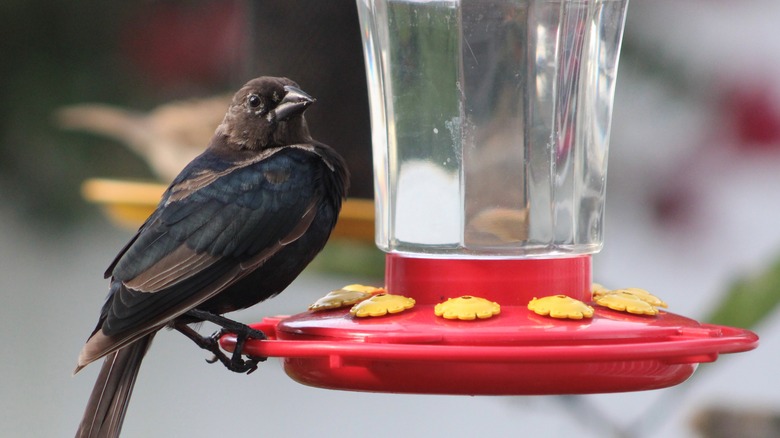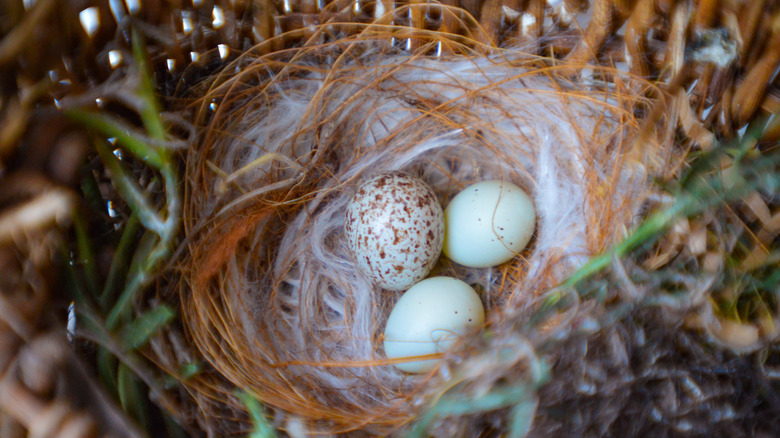The Brown-Headed Cowbird Isn't A Bird Species You'll Be Thrilled To See In Your Yard - Here's Why
The sound of songbirds nesting in nearby trees and filling your yard with their sweet presence is one of the many enjoyable aspects of relaxing outdoors. Birds offer us all sorts of benefits and amusement, from watching them pitter-patter in birdbaths to actively removing unwanted pests and rodents from our midst. But not all songbirds should be welcomed in your yard, the brown-headed cowbird being among them. These invasive songbirds will only decrease the presence of other bird species in your yard, infiltrating nests to promote their offspring while killing off others and flocking around food sources.
Brown-headed cowbirds can be identified by their black feathers with a blue tint, brown heads, and plump bodies. Although, females are entirely brown and don't sport any black coloration. They are native to North America and will invade the nests of more than 200 different species of birds. Understanding precisely how these brown-headed cowbirds negatively impact your property and how to deter them as efficiently as possible is crucial to the longevity of other feathered friends making a home in your yard.
Negative effects of brown-headed cowbirds
The brown-headed cowbird is the most common brood parasite in North America, which means these songbirds lay their eggs in other species' nests and abandon their offspring to be cared for by other birds. This is often at the expense of eggs already in the nest, as the female cowbird will discard eggs to make room for their own. A single female brown-headed cowbird can lay 30 or more eggs each season, usually dropping one or two per nest. Their eggs can be easily pinpointed based on their slightly larger size and brown speckled shell. Additionally, cowbird eggs hatch at a quicker rate, and the chicks mature faster than other species, which can cause original nestlings to be neglected by their parents — and even killed. These invasive tendencies have contributed to the drop in endangered species like the Kirtland's warbler and black-capped vireo birds.
Being extremely smart, brown-headed cowbirds are able to seek each other out by just hearing or seeing another of their kind. This can lead to them flocking around food sources and outcasting other species that have also made a home in the area. The females also show their intelligence with their skilled observation and scouting of nests and laying of eggs at the perfect intervals when a host is away. Like many other birds, these cowbirds eat grasses, seeds, and insects — so how exactly do you stave them off without averting other desired species?
Deterring them from your property
Keeping brown-headed cowbirds away from your property is tricky as it's more complicated than removing their eggs or setting traps. These birds are protected under the Migratory Bird Treaty Act of 1918, which means it is unlawful and forbidden to relocate, kill, or sell brown-headed cowbirds without preapproval from the Department of Interior U.S. Fish and Wildlife Services. And yes, this includes any unhatched eggs. Certain states will allow the capture of these cowbirds if it's an effort to protect an endangered species, but you should always carefully research your state and communities' wildlife laws and policies.
Although physically removing brown-headed cowbirds is likely not an option, there are some crafty ways to decrease their presence. Avoiding platform feeders and instead opting for smaller ones, such as tubular feeders, will make food sources more inaccessible to them without removing them entirely. Clean up any feed that litters the ground, so that even in the lawn, cowbirds aren't able to sit and dine. They also love to snack on sunflower seeds, corn, and millet, so instead, offer up food they are unlikely to eat, like suet, nectar, safflower seeds, and peanuts. You can attempt to protect nests by building shelters that aren't so easily spotted or infiltrated. Also, be sure not to poke around any nests if you suspect brown-headed cowbirds are near, as these observative animals can take notice.

